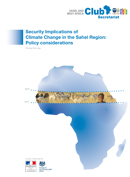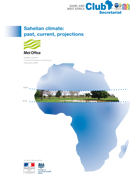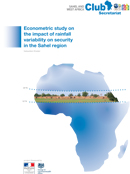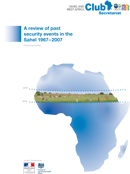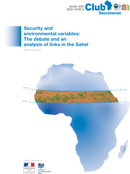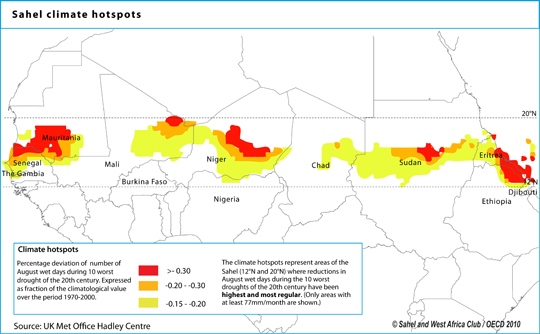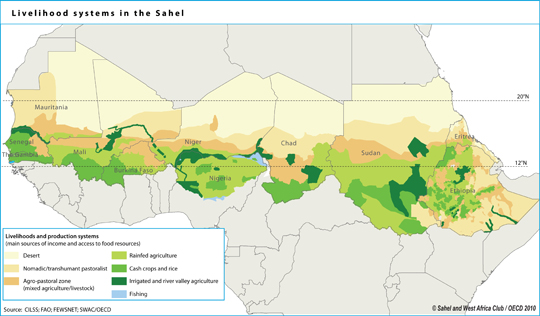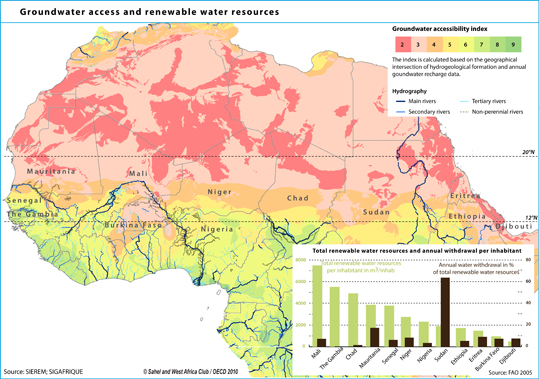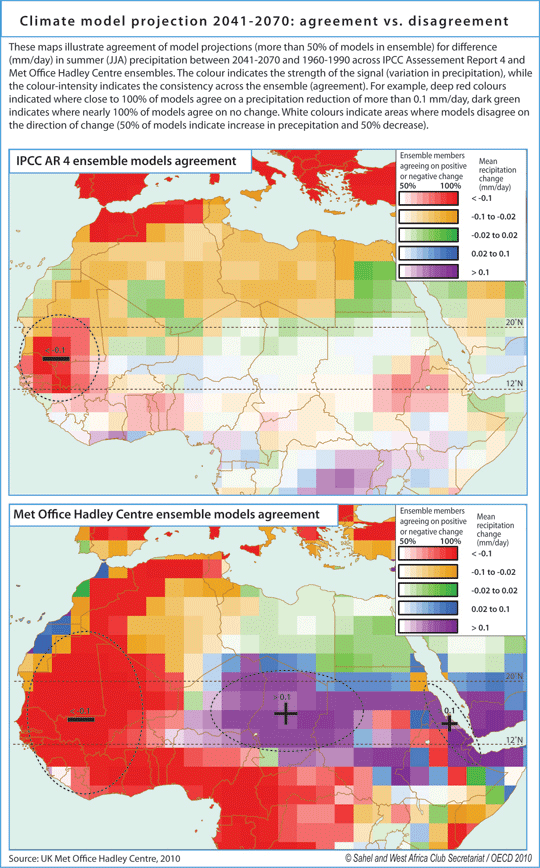Security implications of climate change in the Sahel (SICCS)
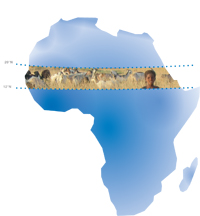 |
International policymaking has over recent years placed climate change impacts as a key threat to state and global stability. The "Security implications of climate change in the Sahel" (SICCS) project, was carried out in 2009-2010 by the SWAC Secretariat. It combined climate, historical, geographical and socio-economic research to analyse the relation between climate change and security in the Sahel. This region is considered particularly vulnerable and is gaining increasing attention due to security, energy and broader geopolitical interests. > executive summary |  |
|
Background
|
Over recent years climate change and its impacts on development and security have become a key concern for policy makers around the world. After decades in which technological innovation, human ingenuity and adaptation and international trade appeared to have overcome many traditional scarcities, the effects of climate change are posing new threats to sustainable growth and development. Africa is considered to be “one of the most vulnerable continents to climate change and climate variability, a situation aggravated by the interaction of “multiple stresses’, occurring at various levels, and low adaptive capacity.” (Intergovernmental Panel on Climate Change - IPCC 2007).
Geographic coverageFor this analysis the Sahel is been defined as the region lying between 12°N and 20°N longitude, covering the semi-arid and arid climate zones. It covers all or parts of 12 countries from the Atlantic Ocean to the Red Sea: Senegal, the Gambia, Mauritania, Mali, Burkina Faso, Niger, Nigeria, Chad, Sudan, Ethiopia, Eritrea and Djibouti. |
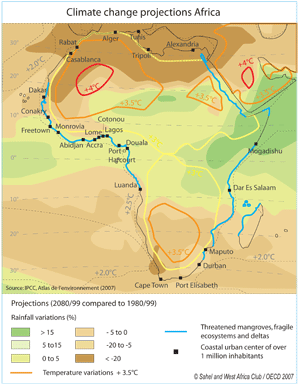 |
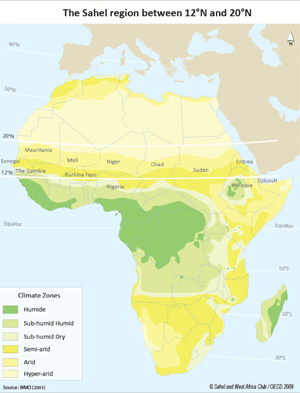 |
Publications
|
|
Security implications of climate change in the Sahel region: policy considerations
Philipp Heinrigs, February 2011 The project ‘Security implications of climate change in the Sahel region’ aimed to increase understanding of the linkages and impacts of climate change and security and on how climate change could contribute to insecurity in the future. This paper summarises and brings together the conclusions of the analyses carried out and identifies key issues for policy makers, specific interest for future work and gaps and uncertainties in existing research. |
|
|
Sahelian climate: past, current, projections
UK Met Office Hadley Centre, February 2010
This study on Sahel climate, climate variability and climate change summarises what we currently know about present and future climate over the Sahel region. |
|
|
Econometric study on the impact of rainfall variability on security in the Sahel region
Sebastian Hissler, November 2009 This paper proposes a two-channel model to identify and analyse the impact of climate variability on security events. Specification of this model is based on a review of quantitative literature, and a specific focus has been made for the results obtained from this model to contribute to a mapping of vulnerability. |
|
|
A review of past security events in the Sahel 1967 – 2007
Emmanuel Salliot, August 2010
> Presentation sheets |
|
|
Security and environmental variables: The debate and an analysis of links in the Sahel
Marie Trémolières, August 2010 This analysis of past security events in the Sahel highlights the complexity of variables intervening in the relationship between climate change and security and the impossibility of defining generalisable qualifications. It stresses the dominant influence of political and economic variables on security and particularly on conflict and promotes orients policy actions towards promoting the well being of populations, focusing on food security and livelihood. |
Maps
|
|
|
|
|
|
|
|
|
|
|
|
Team & Partners
The SWAC Secretariat’s work was supported by a multidisciplinary team of experts. The climate science analysis was provided by the UK Meteorological Office Hadley Centre. The regional analysis also involved a network of stakeholders from Africa and OECD member countries, international and regional organisations, specialised technical agencies and broader interested public and private actors:
- African Centre of Meteorological Application for Development (ACMAD)
- African Union, Peace and Security Department (AU)
- Bureau of Geological and Mining Research (BRGM)
- CILSS/AGRHYMET Regional Centre
- Economic Community of West African States (ECOWAS)
- Food and Agricultural Organization (FAO)
- Famine and Early Warning Systems Network (FEWSNET)
- Intergovernmental Authority on Development (IGAD):
- IGAD Climate Prediction and Applications Centre (ICPAC)
- IGAD Conflict Early Warning & Response Mechanism (CEWARN)
Events
- Security implications of climate change in the Sahel , 22 February 2011, OECD Conference Centre
- Side-event at the UN Climate Change Conference (COP15), 14 December 2009, Copenhagen
- Technical workshop, 17 November 2009, Dakar
Further reading
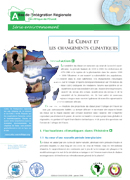 |
Climate and climate change, Regional Atlas on West Africa, chapter 14, SWAC/OECD, West African Studies, January 2008. Like all other world regions, Africa and West Africa must take up the challenge of climate change which is essentially that of vulnerability and uncertainty. Analyses of this region have remained inadequate and the conclusions arrived at by climate projections and their consequences are too uncertain for an effective anticipation of the risks and opportunities linked to climate change. Greater awareness and participation by local actors will also be necessary to formulate and implement these adaptation strategies.
|
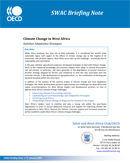 |
Climate change in West Africa: Sahelian adaptation strategies, SWAC Briefing note, January 2009 While Africa produces less than 4% of worldwide greenhouse gas (GHG) emissions, it is considered the world’s most vulnerable region with regard to the effects of climate change due to the fragility of its economies. Like all other regions, West Africa must take-up this challenge – essentially that of vulnerability and uncertainty. In addition to the analysis of the climate change impacts and a presentation of some adaptation strategies developed by agricultural producers in the Sahel, this SWAC Briefing Note presents opportunities and makes recommendations for West African leaders and development partners on how to address West Africa’s climate change challenges. |
Related Documents



